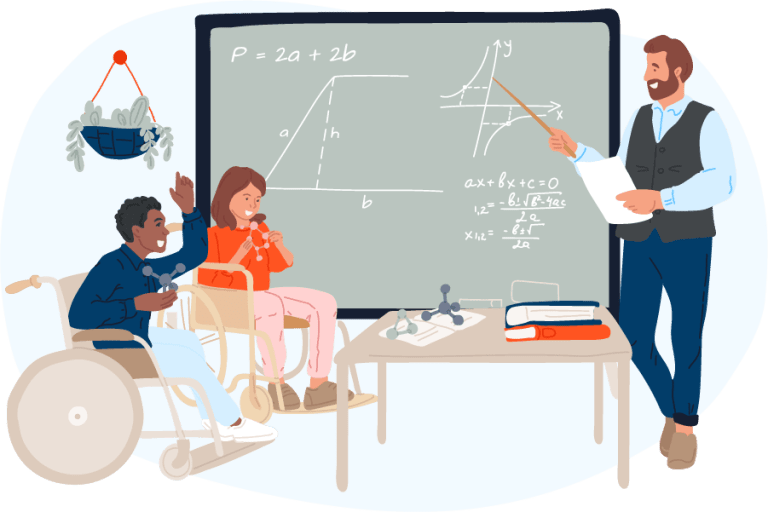A Level 3 Teaching Qualification is designed for aspiring teachers or trainers who want to work within the adult education and skill sector. When teaching, it’s important to share knowledge with the students and address their needs.
This qualification focuses on inclusive teaching and learning approaches to let learners recognise students’ individuality and diversity.
Once enrolled, learners can learn about the importance of inclusive teaching and learning and what approaches they can use to create an inclusive classroom.

What is Inclusive Classroom in Level 3 Award in Education and Training?
An inclusive classroom is a place where all students feel supported be it academically or intellectually.
Inclusivity means including and providing all students with equal learning opportunities, regardless of their background, ethnicity, or culture. Teachers play a key role in creating an inclusive environment where students are not discriminated against but appreciated and encouraged to participate in classroom activities fully.
Level 3 Award in Education and Training recognises the importance of inclusivity by making ‘Understanding and Using Inclusive Teaching and Learning Approaches in Education and Training’ a mandatory unit.
This unit is designed to equip and prepare learners with the knowledge and skills to create welcoming and supportive classrooms.
By understanding and applying inclusive teaching and learning approaches, you can create a classroom where every student feels heard, valued and engaged to reach their full potential.
What are the features of Inclusive Teaching and Learning?
Some of the most common features of inclusive teaching and learning are:
- It provides a safe and psychological environment for everyone
- It promotes active learning and encourages participation
- It makes students motivated
- It boosts their confidence and creates a sense of belonging
- If focuses on versatile teaching and learning styles

How Can You Create an Inclusive Classroom?
Here are some helpful ways on how you can create an inclusive classroom:
1. Create Opportunities to Listen to all Students
Creating a classroom where all students feel heard is extremely important. We all know that some students are too shy or hesitant to speak up in school or a few take time to formulate a response.
Therefore, as a teacher, you must make sure that all of them get the opportunity to be heard in the class, where all students can openly share their answers, thoughts and ideas.
If faced with such a situation, you can give them freedom in how they choose to answer their understanding of a particular question.
For instance, if you are teaching science, students can respond verbally, through drawing diagrams or written reflections. In such a way, you can adapt different learning styles and enhance student engagement.
2. Scaffolding
Scaffolding is the ability to learn information through the help of a more informed individual. It is a teaching approach where teachers support students in learning new skills and material. However, they gradually withdraw this support when students become more experts and competent.
As a teacher, you can use scaffolding to create an inclusive classroom by introducing new topics clearly and simply, supported by visual aids or presentations. You can also offer tiered activities with varying levels of difficulty,
This differentiated approach can help greatly in student engagement and a stronger teacher-student relationship as learners progress at their own desired pace.
3. Be aware of the Diverse Needs of Students
If your class has children with special educational needs and disabilities (SEND), make sure to educate yourself about this. Learn about different social and cultural groups in your classroom.
Also, support all students in ways that benefit everyone. For example, try using different teaching styles so that students who learn best through movement can also learn effectively.
4. Display Schedule and Timetable
There is a higher chance that a student in your classroom has Attention Deficit Hyperactivity Disorder (ADHD) whether it is diagnosed or not. Common challenges for these children include a lack of organisation and time management. To support all students, you can put timetables or class schedules on notice boards which will make it easier for students to stay focused, and on track and organise their tasks accordingly.

What is the Difference Between Inclusion and Differentiation?
Inclusion and differentiation are two sides of the same coin. Both are crucial, however, portray a slightly different aspect.
Inclusion is all about providing and creating a safe environment for all students regardless of their background. Inclusion removes all barriers and offers all students equal opportunities to learn and grow.
On the other hand, differentiation signifies the type of support and help an individual needs. It’s a realisation that each student has their own strength and weaknesses and, therefore, needs tailored support accordingly. Teachers may use different teaching approaches to deliver the same content in order to help the students learn and grow.
What are the Teaching and Learning Approaches?
It would be wrong to say that there is a single recipe for excellent teaching. Teaching approaches are a broader framework that guides and helps teacher how they can structure their classroom and deliver their lecture effectively.
There are two types of approaches: teacher-centred and student-centred. The main purpose of both of them is:
- to facilitate learning
- to transmit knowledge and skills to students
- to develop a deep understanding of concepts and foster critical thinking, problem-solving skills and much more
Now, when you undertake the Level 3 Award in Education and Teaching course you will be asked to compare the strengths and limitations of teaching and learning approaches used in your area of specialism to meet individual learner needs in task 2 of Unit 2. To do so, you are allowed to mention any 5-6 teaching and learning approaches in your response.
Below, we have mentioned a few approaches so that you will have a brief idea of common teaching and learning approaches.
1. Direct Instruction
In the direct instruction method, teachers teach students the new learning material.
They provide examples and non-examples, eliminate ambiguities, and misconceptions and highlight important information to help them understand the concepts.
They break down the material into small, manageable tasks while helping and guiding students step by step in completing learning activities and tasks.
This approach can be used at any level and is helpful for almost all students. However, it is completely the teacher’s responsibility to prepare the lesson with appropriate intensity and apply it strategically to align with the student’s needs and preferences.
2. Inquiry-Based Learning Approach
The inquiry-based learning approach involves the active participation of students with direct questioning and real-world examples.
From the teacher’s point of view, this approach helps students develop their critical thinking – HOW TO THINK instead of WHAT TO THINK – as the whole process includes seeking knowledge through questioning.
For instance, teachers can use ‘what if’ questions to stimulate imagination skills, allow them to think out of the box and encourage them to consider different perspectives.
A science-based ‘what if’ question would be ‘What if dinosaurs hadn’t become extinct’? Asking this question would allow them to develop different hypothetical situations and share unique answers.
3. Student-Centred Learning Approach
In a teacher-centred approach, teachers are experts who guide students and share their knowledge. On the other hand, in a student-centred learning approach, the roles are a bit different as more freedom and autonomy are provided to students by teachers.
- This approach focuses on creating connections between students.
- Furthermore, teachers tailor the learning material according to the learners’ needs.
- Teachers encourage students to navigate and produce solutions to the problem.
- They also encourage them to develop thoughts and solve tasks accordingly.
- As all students are different and unique, this approach requires instructors to adapt to different learning styles.
4. Blended Learning
Blended learning has become an increasingly popular teaching method – as the name suggests, it is an amalgamation of traditional and online learning to make learning more contextual and engaging. It can benefit all learners whether they want to learn in a traditional classroom, online or engage in both learning methods.
In blended learning, it is up to you which material you can share at home and which you want to clarify or reinforce in the classroom the next day. Moreover, with blended learning:
- You can customise the learning material as well.
- You can design interactive presentations or videos which benefit learners who may struggle in physical classrooms.
- You allow students to learn at the pace that best suits them.
Essentially, no matter which approach you use, they all help students in learning growing ultimately toward their motive.
Conclusion
The Level 3 teaching qualification is for those who have little or no experience in teaching or training and still want to pursue this career. This qualification gives learners basic knowledge of teaching roles, responsibilities, and different assessment methods in education and training.
However, the qualification goes beyond just teaching roles and responsibilities; it also covers the importance of inclusivity in education and how to create an inclusive classroom.
It includes various teaching and learning approaches to help create a successful classroom. Learning these strategies and approaches will help individuals adapt and apply them effectively, providing equal learning opportunities for all students.




